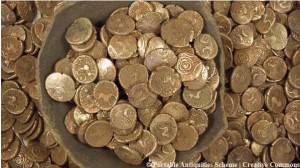Archaeologists excavating the Skopje Fortress have found a chest containing the largest amount of Byzantine-era gold and silver coins ever found in Macedonia. The 44 gold coins from the Byzantine Empire and 76 silver Venetian coins date to the 13th century when the Nicean Byzantine Emperor John III Doukas Batatzes ruled Macedonia. Venice was a major trading partner at that time.
The Byzantine coins bear the images of various kings and Biblical motifs from the reign of John III Doukas; the Venetian coins bear the images of various doges from a wider range of years in the century.
This is the most significant archaeological find at the Skopje Fortress, along with the Medieval lead stamps that were discovered several years ago at the site, Pasko Kuzman, archaeologist and Director of Cultural Heritage Protection in the Macedonian Ministry of Culture, told the Vreme newspaper.
Golden Byzantine coins have been unearthed at other sites in Macedonia, but rarely and in smaller quantities, he added. According to archaeologists, large quantities of bronze coins are often found at ancient sites around Macedonia.
Excavations have been going on in Skopje Fortress for the past three years, but this is the most luxurious find yet. In the same layer where the coins were found, archaeologists also found high quality jewelry that would have been worn by a woman of great wealth.
The period these coins represent was an important transitional phase in the history of Skopje and Macedonia. Byzantine control waned in the middle of the 13th century as Bulgarian feudal lords conquered the territory. Skopje declined as warring factions duked it out, so the Byzantines were able to step into the vacuum for a few decades until the Serbian Empire invaded in 1282.
By the middle of the next century, Skopje was the capital of the Serbian Empire until the Ottomans swept in 1392. They stayed put for over 500 years until just before World War I.
